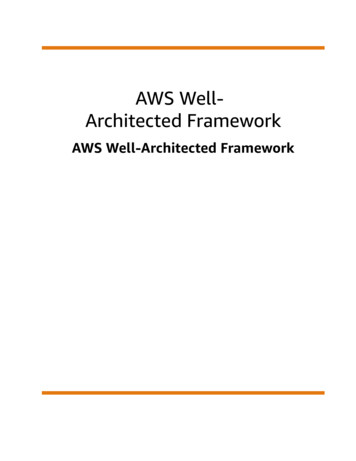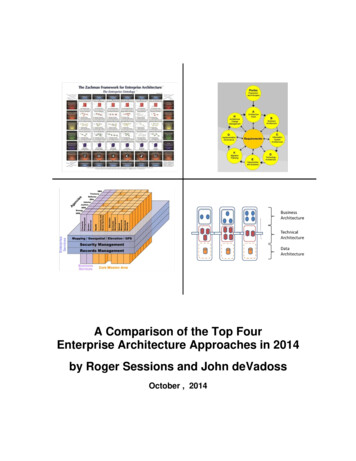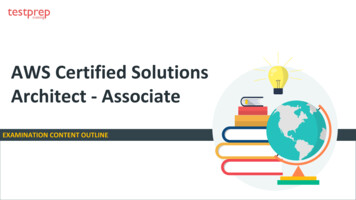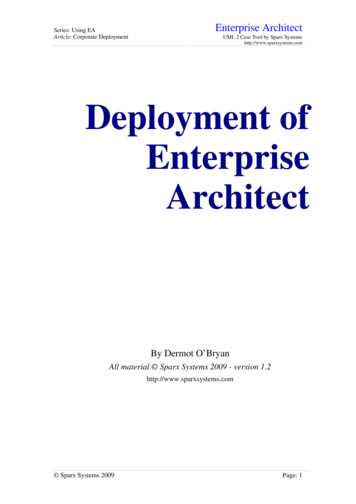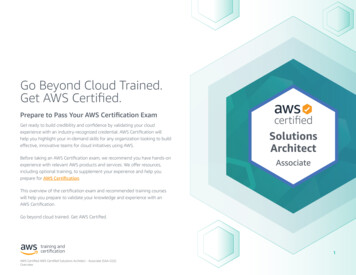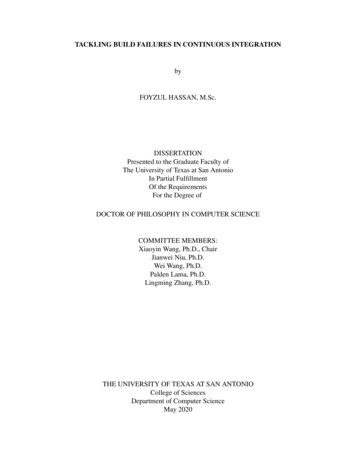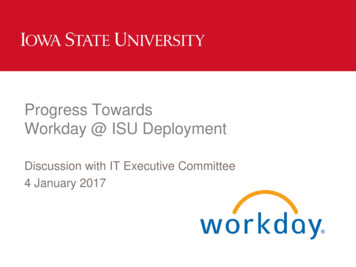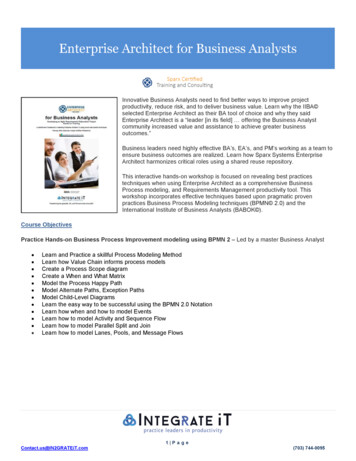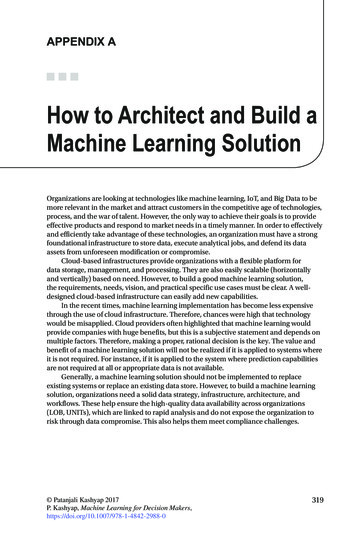
Transcription
APPENDIX AHow to Architect and Build aMachine Learning SolutionOrganizations are looking at technologies like machine learning, IoT, and Big Data to bemore relevant in the market and attract customers in the competitive age of technologies,process, and the war of talent. However, the only way to achieve their goals is to provideeffective products and respond to market needs in a timely manner. In order to effectivelyand efficiently take advantage of these technologies, an organization must have a strongfoundational infrastructure to store data, execute analytical jobs, and defend its dataassets from unforeseen modification or compromise.Cloud-based infrastructures provide organizations with a flexible platform fordata storage, management, and processing. They are also easily scalable (horizontallyand vertically) based on need. However, to build a good machine learning solution,the requirements, needs, vision, and practical specific use cases must be clear. A welldesigned cloud-based infrastructure can easily add new capabilities.In the recent times, machine learning implementation has become less expensivethrough the use of cloud infrastructure. Therefore, chances were high that technologywould be misapplied. Cloud providers often highlighted that machine learning wouldprovide companies with huge benefits, but this is a subjective statement and depends onmultiple factors. Therefore, making a proper, rational decision is the key. The value andbenefit of a machine learning solution will not be realized if it is applied to systems whereit is not required. For instance, if it is applied to the system where prediction capabilitiesare not required at all or appropriate data is not available.Generally, a machine learning solution should not be implemented to replaceexisting systems or replace an existing data store. However, to build a machine learningsolution, organizations need a solid data strategy, infrastructure, architecture, andworkflows. These help ensure the high-quality data availability across organizations(LOB, UNITs), which are linked to rapid analysis and do not expose the organization torisk through data compromise. This also helps them meet compliance challenges. Patanjali Kashyap 2017P. Kashyap, Machine Learning for Decision 9
APPENDIX A How to Architect and Build a Machine Learning SolutionHere are the common steps an organization must take before and after kickingoff machine learning projects. These must be addressed for an effective and efficientmachine learning project implementation: Define the scope. Review the existing system and data governance structures. Revisit security policies and tune them per current needs. Generate a map of existing workflow and relationships betweenapplications and data stores. Create infrastructure, process, and technology maps and highlightstrong and week relations among them. Define the business vision for machine learning. Determine the suitability of technologies for the solution, definebusiness drivers, call out risks, and establish business cases. Define migration strategies for the application, infrastructures,and services. Secure the budget and resources. Define the operational model. Create an implementation roadmap. Determine the implementation plan. Implement it. Evaluate the implementation. Incorporate feedback iteratively. Modify and fine-tune the strategies based on the analysis offeedback. Follow the usual cycle.The primary value of Big Data and machine learning is to bring flexibility andinsight through analysis of complex data sets. Many associated technologies will be partof this suite, including predictive analytics tools, IOT, and cloud technologies, as well asdata modeling, data quality, and cognitive computing frameworks. However, the mostimportant step of any analytical workflow is an efficient data process.The following steps should generally be followed to convert data to insight toits consumption. Following these steps involves confirming that high quality data isconsidered. Also, these would help data scientists analyze the prepared data in thecorrect manner.320
APPENDIX A How to Architect and Build a Machine Learning SolutionThese steps help to convert raw data to insight:1.Gather: Gathering data from heterogeneous sources.2.Discover relationship: Discover the relationship in the existingdata set.3.Organize: Organize and then reorganize the data set forefficient and effective utilization.4.Analyze: Identify and analyze the relationship.5.Generate insight: Generate insight after the analysis of data.6.Report: Report the insight in user understandable format.7.Consume: Consume the insight for the business purpose.Architectural ConsiderationsThe technical architecture for a machine learning solution must be built around needand requirements. Therefore, while designing the machine learning solution, the keydesign considerations must align with these factors: Know your need: Identify your need and define the use casesaccordingly. This will enable proper prioritization of work, sectionof technology, scalability considerations, seamless systems, anddata integration. Define operational strategies: Define the operational strategiesbeforehand in order to execute the solution effectively. Be optimistic about scalability and performance: While creatingmachine learning solutions, an optimistic approach is required.You have to believe as time passes that your organization willgrow and evolve. Therefore, while you are designing the solutionor architecture, your platform must be capable of incorporatingthe growing demand of data and must take care of analysiswithout much change. It must be able to handle data expansioneffortlessly. Strong data access and retrieval strategies are key: Easy tounderstand interfaces, effective tools for storing data, optimizedplatforms, and excellent handling capabilities of unstructureddata are some of the parameters that must be considered duringthe design. These parameters facilitate efficient and effectiveingestion and processing of data.321
APPENDIX A How to Architect and Build a Machine Learning Solution Security controls, logging, and auditing: Security is a keyconsideration for machine learning solutions. Identitymanagement, auditing, and access controls must be designed tocater to the risk levels of the organization and be efficient enoughto handle compliance needs. Access control implementationmust be consistent between access methods. DevOps and Analytics Ops (refer to Chapter 7 for details on theseconcepts): Incredible operational value comes from storing andprocessing heterogeneous sources of data in a machine learningsolution, especially in the cloud environment. Therefore, it isdifficult to manage them manually. Hence, the preferred solutionis to automate deployment and recovery. This would lower theoperational problem on the IT team when making changes andresponding to incidents. Be synchronized with advanced capabilities: Implementingadvanced capabilities, like APIs, parallelization, and cognitivecapabilities is the key to an effective machine learning solution.Therefore, synchronization with the latest advances is a must.Cloud Adoption of a Machine Learning SolutionWhen organizations are planning to put their machine learning solution on the cloud, theyneed to adopt a few specific steps and strategies. In cloud-based environments, ensuringenvironment availability, reliability, and scalability becomes important. It is more relevantin a Big Data/machine learning scenario because of the real-time demand for insight.Therefore, to provide analytics and machine learning as a service, this is a high priority.Blueprinting is a very important activity for designing any architecture. Therefore, abrief description it is provided in the next section. However, these are high-level views. Ifyou need more detail, consider dedicated literature for the appropriate setup.Blueprinting and Machine Learning ProjectsBlueprinting an IT project involves the following:322 Brainstorm with business and technology stakeholders toelaborate, align, and document the scope of the stated businessproblem Translate this problem further to high-level requirements. Come up with various possible technical solutions (includinghigh-level costs and timelines). Align and secure sign-off with the best solution.
APPENDIX A How to Architect and Build a Machine Learning SolutionSubsequent to this exercise, the budget is secured for the implementation projectand a project team is identified and installed. The team refers to the blueprintingdocuments as high-level requirements that furnish the technical requirements, followedby subsequent SDLC phases.It is extremely important to spend time in the brainstorming sessions to understandthe business problem in detail from the business stakeholders.The business stakeholders have a tendency to state the problem at a very high level.Create a questionnaire to probe for the necessary details. That questionnaire shouldcover aspects such as: What is/are the base issue(s)? How is it impacting the business or performance of duties? Are there any financial impacts of this issue? Is the stated functionality actually going to solve the base issue orcreate new ones in the future? Has the business tried to solve these issues before? If yes, what were the shortcomings of the previous solution?For a successful blueprinting exercise, it’s imperative to include all the relevantstakeholders. Here is a typical list of stakeholders and the area of s teamsSign off on the requirements and the chosen solution.Architect/Architectural group Sign off on proposed solution compliance toorganization technology architecture.Designer/design groupProvide input on current state of the system design andcontribute to proposed solutions.Project managerManage budget, resourcing, talent, timeliness, andcoordination of the project.Technology managerProvide roadmap of the technology to the project.Interact with the architect/architecture groups to makesure technical smoothness of the project.Business analystsHelp to understand current business logic and processand give the current state and data flow.323
APPENDIX BA Holistic Machine Learningand Agile-Based SoftwareMethodologyWorkforces in the IT/IS industry are comprised of humans and their complex social,moral, emotional, and spiritual behaviors. When employees come to work, they bringtheir psychological state of minds with them. This affects their interactions with thestakeholders and other activities at work. Having high-level technical skills do notautomatically mean high performance, unless the team members are committed,motivated, and enjoy their work. Therefore, organizations and in turn managers andleaders have to understand the importance of team members’ psychology and behaviorat the workplace, which includes their stress and conflict-handling skills.Employee communication and collaboration abilities in the workplace (especiallyin the IT industry) play a critical role in project success. Alignment of employee values,skills, competencies, and goals with the organization and with clients is important forgood results. Also, proper understanding of the philosophy of technical methodologies isone of the factors for achieving excellence in the deliverables.Many academic studies and professional viewpoints have recognized thesignificance of managing emotions (emotional intelligence, EI) in the workplace. Theability to navigate and facilitate social relationships (social intelligence, SI) and the abilityto apply universal principles to one’s values and actions (moral intelligence, MI) towardworkplace success and organizational efficiency and effectiveness has gained recognitionin professional cycles (for details, refer to Chapter 8).Several emotional intelligence training programs have been established to tuneemployees to the organizational culture and vision, but no framework has beendeveloped (so far) to address employees’ emotional, social, moral, and spiritualcompetencies holistically.The rationale behind this appendix is to underline the importance and applicationof emotional, social, moral, and spiritual intelligence in the software industry andwith technology companies. It also highlights how these competencies can contributepositively toward an organization’s quality of service and deliverables, which willultimately lead to organizational success. Patanjali Kashyap 2017P. Kashyap, Machine Learning for Decision 5
APPENDIX B A Holistic Machine Learning and Agile-Based Software MethodologyIt also discusses an integrative software development methodology based onholistic intelligence ( IQ SQ MQ EQ Social intelligence ingredients of positivepsychology). Technologies are changing dynamically. Every day, something big ishappening in the technical space. But the software methodologies have not changed overthe last few decades. They are forced to fit to the existing ones with the small changes toaccommodate new generations of technical project demand.The GoalThis appendix presents a software methodology that’s based on the Agile softwaredevelopment principles and psychological concepts. The proposed methodology iseffective in designing, executing, and testing highly technical, complex projects, whichoften need with motivation, focus, and commitment from all levels, starting fromprogrammers to clients to leaders. Big Data and machine learning projects fall underthis umbrella (however, they could be applicable to any project). This framework usesintegrative and innovative methods and models to diffuse different leadership techniqueswith information technology (IT) and software development.Proposed Software Process and ModelAgile is a fundamental change in how people manage projects if it is compared towaterfall techniques. Delivering workable software on time is what actually measuresthe success of a project. However, software delivery is not enough. The quality of thedelivered project, stakeholder satisfaction, and workforce happiness are also veryimportant. If the workforce is happy, they will be more productive, creative, andinnovative and therefore be able to create more robust solutions. Existing softwaremethodologies typically cater to the few administrative and technical success factors ofsoftware development projects, like timely delivery of workable software and keepingprojects within budgets. Often, behavioral and psychological success factors are not beingaccommodated in the project in any considerable way.Thus, the overall existing process, including the software methodologies, need tochange the fundamental way of thinking. Organizations have to change or fine-tune theold management style by making it more dynamic and customizable, per project needand demand. One standard management style across the organization will not be ofmuch use. Customized and personalized management styles on a project basis are theneed of the hour. The behavior of the programmers—their psychology and skills—needsto adjusted or modified based on the need of the project. This can be done by usingmachine learning, Big Data, and cognitive computing techniques.The machine learning analytics based software development methodology iscapable of bringing dynamism and agility to the development methodology itself withcontinuous learning and adaptability. The expectation is that the model must learnfrom the continuous changing behavior of the people who are the part of the projectand in turn with the organization. The model can analyze all the data available in theorganization in all forms and suggest the appropriate customized software process andmethodologies based on the availability of skills, processes, technologies, and people.326
APPENDIX B A Holistic Machine Learning and Agile-Based Software MethodologyThis includes charting out the guidelines for planning, developing, and executing in anautomated way with no or very little human intervention.The model will also suggest the appropriate customized software methodologybased on the requirements. For example, the machine learning and predictive analyticstechniques will enable the model to evaluate and analyze the requirements, includinginputs from similar projects that the organization delivered in the past. The model canstudy the scope of work by using SOW documents, accessibility of the self-components,present talent availability, time to deliver the project, character, and behavioral analysisof the stakeholders/team members, and then determine that the project needs a mixof Agile, waterfall, and Kanban methodologies. Then it would generate customizedmethodologies with the guidelines for implementation, process, and other action items.It then can predict its success percentage on the solid foundation of data, statisticaltechniques, and analytics.Problem StateMost software methodologies are based on mathematical and statistical techniques andnot on the people factor. Therefore, several problems occur. Although all methodologiesare implemented by humans, they do not consider the psychological state of thehuman being on work during the overall project lifecycle. It is well known that overallproductivity and project success depend heavily on the psychological well-being ofthe individuals and of the group. For any project to be successful, we have to take intoconsideration the human factors along with the technical factors.SolutionHolistic intelligence maps the complete personality of humans. People having holisticintelligence can communicate with the outer world effectively and efficiently, andalso with their inner world (their own minds) with confidence. The proposed softwaredevelopment methodology is the integration of holistic intelligence with Agilemethodology.Holistic intelligence is applicable everywhere—during the requirements gathering,design, testing, and implementation phases of software development. It deals withhumans and their psychological states and human intervention and involvement existsat all phases of the software development lifecycle. Therefore, to make the methodologymore robust and efficient, there is a need for holistic thinking, which includes technical,behavioral, and intellectual skills. Proper application of this proposed methodologywill increase the knowledge workers’ productivity. For example, in the process ofimplementing software, the programmers’ emotional and social competences becomeimportant, because if these competencies are present in the programmers, it will helpthem better interact with team members, clients, and other stakeholders.The humans/programmer/knowledge workers are not necessarily equipped withall these competencies. You must be aware of all of their hidden potential at the start ofthe project. So, once the team is onboarded with the bare minimum qualifications, thedesired competencies should be incorporated in the progress of the project. This can bedone in an iterative way, whereby the core competencies are cultivated first in the peopleinvolved and the rest later exactly like the Agile methodology.327
APPENDIX B A Holistic Machine Learning and Agile-Based Software MethodologyAs projects proceed, training is added to the cycle to improve the holistic intelligenceparameters of employees, resulting in more efficient and well-prepared individuals.The training program will be done again in an iterative way: training evaluation performance feedback more training. That way, the right feedback can correctly assessindividuals’ progress and competency without having an adverse effect on the project.WorkingThis methodology can be technically implemented in multiple ways. One method ofapplying it is described next.The ProcessWhen companies or organizations recruit employees, they ask for all the information todetermine if the prospective employee is the right person for the job. The informationranges from grades to professional experience. In time-based projects, it is very importantto pick the right set of people; hence, this information matters because it provides insighton the person’s technical expertise. These information in turn could be mapped to theprofessional expertise of the resource to the specific needs of machine learning, cognitivecomputing, and Big Data analytics-based projects.Also based on these techniques, a model could be created that provides appropriatesuggestions based on the project requirements. This “insight” is generated on the basis ofinformation stored in the database that defines an individual’s intellectual capability. Italso helps an organization pick people who are suitable for projects in the centralized way.Many organizations have similar databases; however, they do not contain allthe behavioral data of an individual. This ranges from individual details scattered atmultiple places, including social media and other unstructured data. This need justifiesthe importance of integrative database or “organizational professional database”. The“integrative database” or “organizational performance database” will contain all thecontent of the employee/ perceptive employee to the extent of behavioral history,personality type, strength and weakness, and emotional and spiritual parameters.In Agile methodology, when teams develop software, they use pair programmingfor coding. Pair programming is a software development technique in which twoprogrammers work closely together at one workstation. The driver transcribes code whilethe navigator analyzes, accesses, and reviews each line of code as it is typed. In this way,while reviewing, the navigator can deliberate the strategic path to the coding work. Thenavigator also comes up with ideas for improvements and provides insights on futureglitches to address. The driver’s main responsibilities are to focus on the “tactical” aspectsof implementation of the present task. In this process, the driver generally uses thenavigator as a safety net and guide.The integrative database can be helpful in this type of situation, in order to pick theright resources that would play these roles based on the gathered insights on the datastored. Picking the right resources will result in cooperative and more efficient teams,because team members are selected on the basis of behavioral patterns. This is just oneexample of applying the database to many development methodologies.328
APPENDIX B A Holistic Machine Learning and Agile-Based Software MethodologyRelevance and Future Direction of the ModelNo attempts have been made to date to combine social and spiritual intelligence with Agilesoftware development methodologies. These factors (social and spiritual intelligence) helpdevelop one model/framework and innovative methods/calculations, which will providea new dimension to software development techniques. To improve this methodology,multiple tools need to be developed. A few are mentioned in Figure B-1.Figure B-1. Combining social and spiritual intelligence with Agile software developmentmethodologiesThe best way to change problematic behavior is to understand the issues that driveit and then design a plan to combat it. For example, violent conduct may be motivated bydistress and anxiety, by cluelessness, or by a wish to govern and control team members.The workplace should be a place of peace and positivity in order to enable quality workand innovation. Teams/individuals are supposed to contribute toward and maintain thatpeace. One of the prime reasons for emotional imbalance, including aggression, is fearand insecurity.These toxic behaviors can be controlled if managed with tolerance and reassurance.Unmanaged emotions worsen all types of problems. Therefore, better understandingof emotions and social behavior is required even in the workplace. The better youcomprehend how other individuals see the world and what inspires them, the better youwill be able to motivate them to perform in helpful ways. The more you identify, analyze,and understand what inspires individuals of different personality types, the better youwill be able to shield yourself and inspire them to collaborate with you and providethe work per the requirements. Toxic behaviors generally create problems in softwaredevelopment environments/teams, because ultimately software development is a teamactivity. Individual-based projects generally fail. The chances of success of team-basedprojects are high, no matter how complex they are.This proposed model can be helpful in understanding difficult people and thencorrecting their behaviors. The goal is to align them with the organization’s vision,mission, and propose. Ultimately, this harmony will percolate down to the project level.329
APPENDIX CData ProcessingTechnologiesMultiple tools and technologies for data processing are described under the Big Dataanalytics technology stack in Chapter 4. However, many other technologies exist as well,and it is good to know about them for a complete understanding. Covering all the tools isbeyond the scope of this book, but the tables in this appendix provide brief explanationsof some of them.Table C-1. Data Gathering and Processing Tools and TechnologiesPurposeToolsData integration Enterprise datawarehouse Enterprise reportingSAP, BDOS Oracle DI, IBM Data Stage, IBMInformation Analyzer, Business Glossary,IBM MDM, DB2Data modeling MDM data conversion/ Trillium, D3JS, IDL, Riverstand, TIBCOmigrationSpotfire, 17 Tableau, SSRS, SSAS, PowerToolsData profiling Data quality DatagovernanceErwin, ER/Studio, Visio, DB DesignerData integration Enterprise datawarehouse Enterprise reportingSAP, BDOS Oracle DI, IBM Data Stage, IBMInformation Analyzer, Business Glossary,IBM MDM, DB2Text mining Data streaming Complex SAP MDM, Oracle MDM, 18 Oracle Essbase,event processing19 IBM, COGNOS, MicroStrategy, SAP BO,Oracle OBIEEBig Data Social mediaSAP HANA, Oracle Exadata, Oracle Times 10,Terradata, IBM Netezza, HP Patanjali Kashyap 2017P. Kashyap, Machine Learning for Decision 1
APPENDIX c Data Processing TechnologiesTable C-2. Analytical Tools and TechnologiesPurposeToolsCluster analysis Statistical testing, such ast-test, chi-square, and ANOVA Latent classanalysis Discriminant analysisSAS, SPSS, R, Python, Knex, Knime,Weka, MiniTab, Mahout, ilog, Matlab,Statistica, EvolveDescriptive analytics Univariate analytics Bivariate analytics Multivariate analyticsHadoop, HBase, Hive, Spark, Storm,Splunk, Pig, OozieMonte Carlo analysis Conjoint analysis Retention analysis Survey analysis Lifetimevalue analysisMondoDB, CouchDB, Neo4J, Infinitie,MarkLogic, Amazon Dynamo, TITANCampaign analysis Pricing analysis Survivalanalysis Pareto analysis Quality controlanalysisUIMA, Rapid Miner, Tresseract Café,Brandwatch, Crimson Hexagon,Radian6, Symosis, LithiumChaid analysis Regression analysis Decisiontrees Neural networkApache, Cloudera, 16 Hortonworks,MapR, IBM, Cassandra, Hypertable,Amazon332
BibliographyMachine Learning, Big Data, IoT, and Cloud and Cognitive Computing:1.Data Science for Dummies, 2nd Edition.2.Olsen, Dan. The Lean Product Playbook: How to Innovate withMinimum Viable Products and Rapid Customer Feedback.Wiley. 2015.3.Newport, Cal. Deep Work: Rules for Focused Success in aDistracted World. Grand Central. 2016.4.Christensen, Clayton M., Allworth, James, & Dillon, Karen.How Will You Measure Your Life. Harper Business. 2012.5.Xamarin Continuous Integration and Delivery6.Schwab, Klaus. “The Fourth Industrial Revolution”. 2016.7.Gertner, Jon. The Idea Factory: Bell Labs and the Great Age ofAmerican Innovation. Penguin Press HC. 2012.8.Christensen, Clayton M., Allworth, James, & Dillon, Karen.Competing Against Luck: The Story of Innovation andCustomer Choice. HarperBusiness. 2016.9.Stigler, Stephen M. The History of Statistics: The Measurementof Uncertainty Before 1900. Belknap Press. 1986.10.Stigler, Stephen M. The Seven Pillars of Statistical Wisdom.Harvard University Press. 2016.11.Akerlof, George A. & Shiller, Robert J. Phishing for Phools:The Economics of Manipulation and Deception. PrincetonUniversity Press. 2015.12.Akerlof, George A., Kranton, Rachel E. Identity Economics:How Our Identities Shape Our Work, Wages, and Well-Being.2010.13.Ellenberg, Jordan. How Not to Be Wrong, The Power ofMathematical Thinking. Penguin Press HC. 2014. Patanjali Kashyap 2017P. Kashyap, Machine Learning for Decision 3
Bibliography33414.Tapscott, Don & Tapscott, Alex. Blockchain Revolution: Howthe Technology Behind Bitcoin Is Changing Money, Business,and the World. Portfolio. 2016.15.Tetlock, Philip E. & Gardner, Dan. Superforecasting: The Artand Science of Prediction. Crown. 2015.16.Ford, Martin. The Lights in the Tunnel Automation,Accelerating Technology and the Economy of the Future.CreateSpace. 2009.17.Ford, Martin. Rise of the Robots Technology and the Threat of aJobless Future. Basic Books. 2015.18.Ross, Alec. The Industries of the Future. Simon & Schuster.2016.19.Rogers, David L. The Digital Transformation Playbook:Rethink Your Business for the Digital Age. Columbia UniversityPress. 2016.20.Hay, Louise. Heal Your Body. Hay House, Inc. 1976.21.Dispenza, Dr. Joe. You Are the Placebo Making Your MindMatter. Hay House, Inc. 2014.22.Sims, Christopher A. Tech Anxiety Artificial Intelligence andOntological Awakening in Four Science Fiction Novels23.Starkes, Janet L., Ericsson K. Anders. Expert Performance inSports24.Ericsson, K. Anders. Development of Professional ExpertiseToward Measurement of Expert Performance and Design ofOptimal Learning Environments25.Eagleman, David. The Brain: The Story of You.26.Sauro, Jeff. Customer Analytics For Dummies.27.Laursen, Gert H. N. Business Analytics
capabilities is the key to an effective machine learning solution. Therefore, synchronization with the latest advances is a must. Cloud Adoption of a Machine Learning Solution When organizations are planning to put their machine learning solution on the cloud, they need to adopt a few specific steps and strategies.
